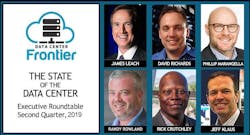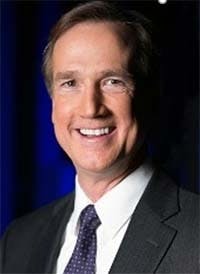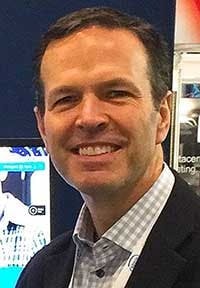Executive Roundtable: The State of the Hyperscale Data Center
Welcome to our 15th Data Center Executive Roundtable, a quarterly feature showcasing the insights of thought leaders on the state of the data center industry, and where it is headed. In our Second Quarter 2019 roundtable, we examine four topics: trends in hyperscale data center leasing, the opportunities in edge computing, strategies for enterprise transition to third-party facilities, and how powerful new AI hardware is impacting data center design.
Here’s a look at our distinguished panel:
- Rick Crutchley is vice president and general manager of North America for Iron Mountain and is responsible for providing global leadership for the company’s operations and sales.
- Jeff Klaus is General Manager of Intel Data Center Software Solutions, leads a global team that designs, builds, sells and supports Intel DCM software.
- David Richards is the Product Manager of Open Systems at Chatsworth Products and a 30-year veteran of the telecom and IT industries.
- Randy Rowland is the President – Data Center Services at Cyxtera Technologies and is responsible for strategy, business management, operations, product development and evangelism.
- Phillip Marangella is the Chief Marketing Officer at EdgeConneX, with 20 years of international marketing, strategy, and business development experience.
- James Leach is the Vice President Marketing at RagingWire Data Centers, and marketing leader responsible for a data center portfolio of 2 million square feet.
The conversation is moderated by Rich Miller, the founder and editor of Data Center Frontier. Each day this week we will present a Q&A with these executives on one of our key topics. We begin with a look at our panelists’ take on the outlook for hyperscale data center leasing.
Data Center Frontier: After a year of blockbuster leasing in 2018, the large hyperscalers appear to be less active in procuring new capacity in the first half of 2019. What does the prognosis for hyperscale deals look like in the short and long term? Are these requirements changing in size or structure?
JAMES LEACH, RagingWire Data Centers
James Leach: I can’t imagine ever describing a hyperscaler as being “less active” in anything! They are actively deploying massive amounts of compute, storage, and network around the world. They are promoting, expanding, and developing renewable energy options for data centers. They are driving new efficiencies in data center designs and operations.
What we’re seeing from the hyperscalers is more effective capacity planning, a desire for more precise delivery windows, and a need for onsite deployment services and project management – all of which we are delivering. With the roll-out of new subsea cables and dark fiber, look for the hyperscalers to expand network capacity, management, scalability, and resiliency to compliment the advances they are making in their compute and storage platforms.
RICK CRUTCHLEY of Iron Mountain.
Rick Crutchley: We’re still seeing steady demand. Hyperscalers continue to get aggressive on pricing with numerous suitors willing to play, driving historic lows for $/kw. Sustainability is a focus of most hyperscale deals, as these organizations continue to use their buying power to create data center scenarios that are good for the business, customers, and the environment.
Design requirements/preferences continue to be unique to the individual hyperscale company in question, offering a build challenge for colocation providers, as designing to one hyperscale prospect can potentially eliminate them from consideration for other opportunities – or add significant costs in order to adjust. Size range: 5 MW to 40 MW.
PHILLIP MARANGELLA, EdgeConneX
Phillip Marangella: I think it depends on the market, the customer and the deployment type. A few major markets are probably seeing some absorption of capacity, while many other markets, particularly internationally, are still seeing very strong demand and growth.
However, no matter the provider or the location, the one thing that I think is consistent for all providers is their desire to extend their footprints to more markets in order to have their services available in closer proximity to their customers and end users. And, while the requirements for cloud continue to evolve as it matures, and as adoption and usage accelerate, the equally rapid rise of interdependent technologies like IoT, machine learning and AI, gaming and others are also impacting demand for data center capacity around the world. The net-net is that there is and will remain strong global demand for hyperscale data center capacity across core, edge and hyperlocal markets and everything in between.
JEFF KLAUS, General Manager of Intel Data Center Management Solutions
Jeff Klaus: Hyperscalers have continued their strong growth, it may have changed location but it’s still going strong. For example taken from Data Center Frontier:
Data center operators in Northern Virginia leased 270 megawatts of capacity in 2018, more than doubling the previous record for annual absorption, according to data from Jones Lang LaSalle, which said the region accounted for 55 percent of all data center leasing nationally.
I think prices have started to make people look for quality opportunities but things are still moving. For example:
Digital Realty… has purchased a 13-acre property on Filigree Court in Ashburn from Airbus Americas for $28 million, according to the Washington Business Journal, citing local property records. The purchase price works out to $2.14 million per acre, the highest price yet for a data center development property in Loudoun County.
DAVID RICHARDS, Chatsworth Products Inc. (CPI)
David Richards: In general, the size of builds is increasing. It is important to remember that each generation of compute provides a significant increase in compute capacity and better overall hardware utilization. So, the amount of hardware per compute capacity is shifting. Hyperscale will continue to grow and to lease colo space, but the compute capacity in each rack is also increasing.
Additionally, the emergence of 5G and increased demands for mobile computing have created a need to observe and create the next natural evolution of data center design, layout and operations. Once this evolution pans out, I believe hyperscale will be in position to confidently continue to multiply to support the increased wave of data flow and storage needs that comes along with it.
RANDY ROWLAND, President of Data Center Services at Cyxtera
Randy Rowland: As an enterprise retail colocation provider, Cyxtera is not in the hyperscale or wholesale business so we’re not able to speak to the prognosis for hyperscale deals. We are seeing a trend in which hyperscalers are building out larger volume capacity sites. Enterprise customers and large systems integrators need to factor in the added cost of the build out and management of power, cooling, and operations if they’re seriously considering hyperscalers as a potential retail colocation alternative.
We’re also seeing that the presence of a hyperscaler in a metro region drives enterprise retail colocation demand in that same market. In fact, we partner with many of the hyperscalers to address this enterprise demand. Our customers are mid-to-large enterprises, more than half of which operate in multiple locations, many on a global scale. They operate hybrid IT environments in our data centers that need low-latency on-ramps to their cloud provider of choice.
We continue to strategically invest in and grow our global footprint in response to customer demand in these markets, with turnkey sites offering a diverse range of interconnection options to cloud providers. This is evidenced by our recently announced expansions in eight key markets across North America and Europe, including new data center openings in Phoenix and Frankfurt and expanded capacity in New York Metro, Silicon Valley and London.
NEXT: Where are the opportunities in edge computing?
Keep pace with the fact-moving world of data centers and cloud computing by following us on Twitter and Facebook, connecting with me on LinkedIn, and signing up for our weekly newspaper using the form below:
About the Author





